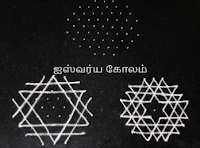Idhaya kolam or thamarai kolam is drawn as shown in the image above. Place five dots in eight directions. The first set of lines is shown on the top left of the image. These kolams are drawn on
Fridays in Pujai room only. They can also be drawn for Tulasi
maadam. Decorate with kaavi The first kolam is Aiswarya kolam or Iswarya kolam .
The image above shows the step-by-step procedure to draw the kolam. The dot pattern is 7 dots at the centre, 8,7,6,3 on either side.
Many viewers on Facebook, YouTube and Instagram ask me as to what kola podi I use because it has the good qualities of
both kolam powder and rice flour, where do I purchase, is it any special type of powder etc. are some of the doubts in the viewer's mind
I purchase kola podi from the local vendor only. In Tamil Nadu you can find street vendors on vehicles selling white rangoli powder
It is also available in some shops in areas like Mylapore, West Mambalam and Triplicane. Of course you can purchase online too
I sieve the kola podi I purchase. Then I add rice flour. The ratio is 3:1 i.e. for 3 parts of kolam powder I add one part of rice flour
After adding I mix both for a few minutes so that they get mixed thoroughly. The resultant mixture is used by me
for drawing kolam for my daily kolam at the entrance and Pooja Room. I sue the same powder for my demo videos on social media


You may wonder why I am repeating the ratio of kola powder and rice flour used in quite a few posts. There may be some readers who visit the blog for a couple of posts and go away. They need some information urgently and when they get it they exit the site. They may come back later and read a lot of posts if it interests them.
I wish to reiterate that my aim is to encourage our younger generations to practice this art daily at the entrance so that the continuity of the tradition is maintained. One of the reasons that practitioners may get discouraged if they do not get good lines is the quality of kolam maavu.
I think this major problem can be overcome when they use the mixture in the ratio, I have shared. This optimum ratio is based on my experience. The feedback I have received from viewers is also positive.
So, the intention of sharing this ratio is quite a few posts is to ensure that the probability of readers visiting the blog gaining this information is more.
I draw both the kolam, images for which I have shared above with the steps, in the Pooja room. Invariably I draw a new kolangal on Wednesday or Thursday. If time permits, I draw one more
beautiful rangoli between these two.
The next two images show a vellikizhami Poojai arai kolam (Pooja rangoli for Friday).
The dot pattern shown in the above image is placed in the following order. First place four dot on four sides. Then between any two dots place a dot. Now place two dots between any two dots. This way there will be more or less an even gap between any two pulli. Decorate with kavi powder or colours. We can draw for Navarathri kolu too.
Bookmark these chukki rangoli for Varamahalakshmi festival .




Comments